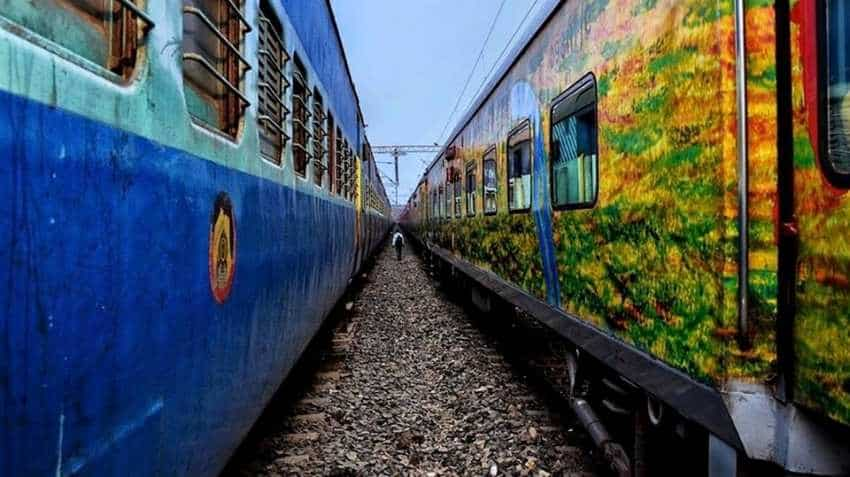Even as petrol, diesel prices hit your pocket, this smart move by Indian Railways saves Rs 1 cr a month
Rise in petrol and diesel prices is due to boiling international crude oil and weak rupee.

When last week, the NDA government trimmed the excise duty, there was a collective sigh of relief from Indian citizens. Right after the excise duty cut, many states also decided to lower their petrol and diesel prices. However, the ‘achche din’ were short lived as today, once again, prices of petrol and diesel were hiked. Fuel rates are rising due to boiling international crude oil and weak rupee. Interestingly, this is something that is not really worrying the Indian Railways. Why? Railways have set a plan in motion that is helping it save massive amounts on fuel costs.
According to a Times of India report, to tide over the pinch of surging fuel prices, the Southern Railway has implemented a technology that draws power from overhead lines for electrical appliances in Linke Hoffman Busche (LHB) coaches.
This smart move which is incorporated in 23 rakes, has reportedly resulted in savings of about Rs 1 crore per month on fuel alone.
It is being known that, LHB coaches are much safer than the traditional coaches of India which are designed by Integral Coach Factory (ICF) due to various features.
Not only this, the LHB coaches are lighter and hence are very useful for semi-high speed trains. Notably, unlike the ICF coaches, the LHB coaches do not have an alternator like generating electricity to power the electrical appliances as the train moves.
Therefore, every LHB coach has one or two power cars situated at end of the train, where electricity is supposed to produced in a diesel generator. This generator in railway terms is known as End on Generation (EOG).
Top officials told the news agency, For a 15-hour journey, 1800 litres of diesel is burnt. An air-conditioned coach consumes 30-40 litres of diesel per hour.
Reportedly, the power car needs 40 litres of diesel per hour per non-AC coach. While an air-conditioned coach, needs 65-70 litres per hour. Furthermore, a litre of diesel gives about three units of electricity. This means a non-AC coach uses somewhat 120 units of electricity per hour.
Calculating the diesel expenditure, it was revealed that the cost is Rs 2,800 per hour at the rate of Rs 70 per litre.
But as the Southern Railway gets electricity from Tangedco at the rate of around Rs 7 per unit, the expenditure on electricity comes down to Rs 840 per hour in a non-AC coach.
Such is definitely far more cheaper than the usage of diesel in the power car.
Additionally, there were also huge savings on maintenance of diesel generators, which is a costly affair, as per the officials in the report.
On October 04, the government cut excise duty by Rs 1.50 per litre in petrol and diesel. Further, the Finance Ministry also asked OMCs like HPCL, IOCL and BPCL to absorb Rs 1 per litre cut in fuel prices. This would mean a relief of Rs 2.5 per litre in petrol and diesel. The government would bear about Rs 10,500 crore losses due to this movement.
After government cut excise duty, states like Maharashtra, Gujarat, Goa, Uttarakhand, Chhattisgarh, Haryana, Uttar Pradesh, Jammu & Kashmir, Assam, Tripura, Himachal Pradesh, Madhya Pradesh and Jharkhand also gave another Rs 2.5 per litre relaxation in the price of petrol and diesel.
Taking into consideration both the relief, the actual price of petrol and diesel came down by almost Rs 5.
However, today, once again the upswing in fuel prices has emerged. A litre of petrol was priced at Rs 82.03 in New Delhi (from previous price of Rs 81.82), at Rs 83.87 in Kolkata (from previous price of Rs 83.66), at Rs 87.50 in Mumbai (from previous price of Rs 87.29) and at Rs 85.26 in Chennai (from previous price of Rs 85.09).
Meanwhile, a litre of diesel was available at Rs 73.82 in New Delhi (from previous price of Rs 73.53, at Rs 75.67 in Kolkata (from previous price of Rs 75.38), at Rs 77.37 in Mumbai (from previous price of Rs 77.06) and at Rs 78.04 in Chennai (from previous price of Rs 77.78).
03:29 PM IST






 Booked IRCTC ticket before Coronavirus lockdown? These two 24-hour Indian Railways helpline numbers will answer all your inquiries
Booked IRCTC ticket before Coronavirus lockdown? These two 24-hour Indian Railways helpline numbers will answer all your inquiries 7th Pay Commission Sarkari jobs: Bumper Rs 5,500 monthly salary hike for these employees; Level-9 grade pay after promotion
7th Pay Commission Sarkari jobs: Bumper Rs 5,500 monthly salary hike for these employees; Level-9 grade pay after promotion Booked IRCTC ticket but caught in Coronavirus lockdown? Save your money, don't cancel your ticket, follow Indian Railways refund request
Booked IRCTC ticket but caught in Coronavirus lockdown? Save your money, don't cancel your ticket, follow Indian Railways refund request Railway units now preparing sanitisers to meet demand
Railway units now preparing sanitisers to meet demand Indian Railways passengers ALERT! Don’t cancel your tickets, IRCTC to give full refund
Indian Railways passengers ALERT! Don’t cancel your tickets, IRCTC to give full refund